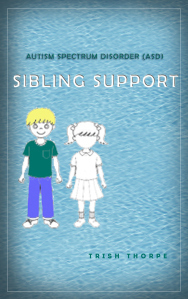Autism Spectrum Disorder (ASD) Sibling Support Handbook (updated Jan. 2015)
The world of the autistic child changes in an instant, and the professional psychology community makes decisions based on that ever-changing world. In an effort to��stay current with the latest thinking, I updated my ASD sibling support handbook. My goal when I set out to update my book was to blend the latest discoveries from��professional psychologists with my own experiences growing up as an ASD sibling.
The latest Diagnostic and Statistical Manual of Mental Disorders (DSM) now categorizes Asperger’s Syndrome as part of Autism Spectrum Disorder (ASD), instead of as a
separate impairment. I wanted to make sure that the content of my handbook addressed that change.
 While doing research, I learned a new term that I wanted to share: “glass children.” To me, “glass children” is a wonderful visual that can be used to illustrate the see-through existence��of the special-needs sibling. I used it throughout��my book to call attention to that plight. I learned the term from a TED talk by Alicia Arenas: https://www.youtube.com/watch?
While doing research, I learned a new term that I wanted to share: “glass children.” To me, “glass children” is a wonderful visual that can be used to illustrate the see-through existence��of the special-needs sibling. I used it throughout��my book to call attention to that plight. I learned the term from a TED talk by Alicia Arenas: https://www.youtube.com/watch?
v=MSwqo-g2Tbk
Also, I added a short story called “Spencer’s GIFT.” I recently re-read “The Gift of the Magi” by O. Henry and it reminded me of the challenges of gift-giving. I wanted to write a story that illustrated that same kind of challenge from an ASD sibling’s perspective.
What hasn’t changed is my passion for raising awareness of the difficulties��of the ASD sibling. My eagerness to share what I learned from my own experience remains steadfast. Here is a sampling of the tips that I provide in my book that are based on professional research as well as my own experience as an ASD sibling:
TIP #8. Create Personal Space
Your ASD sibling needs to feel entitled to their own belongings and their own private place in the world. This will hopefully reinforce the notion that they are a complete person separate from their role as an ASD sibling.
Find a spot in your home that they can call their own. It doesn���t have to be big. It can even be as simple as a shelf or a drawer. Just something that is solely theirs. Make sure that both your ASD sibling and your ASD child understand the boundaries.
TIP #12. Share a Secret Code
Make it clear that they can come to you with questions and concerns at any time. Take time out to tell them that you���re always willing and available to talk.
Strategize a signal together that can be used to alert each other that something���s wrong when others are in the room. It could be either a specific word or gesture, just so that you use it specifically for these situations. Sharing a ���secret code��� together will re-confirm to them that they���re not alone.
I do understand that creating��a balanced household in a special-needs situation is��not easy. In my mind, it’s vitally important to consider the needs and feelings of neurotypical siblings while maintaining��that balance.
Here’s a link to my handbook:




